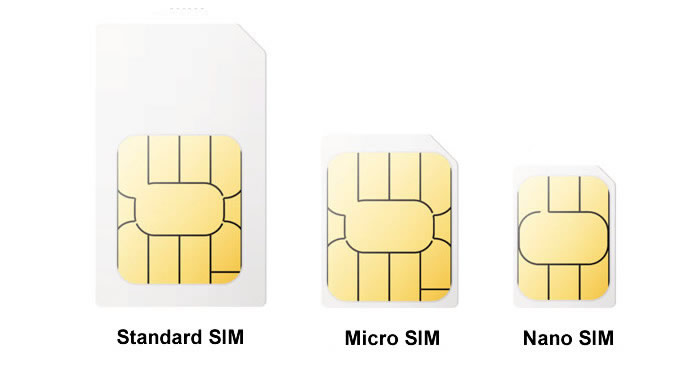
SIM card sizes can be complex to understand for beginners. Over the years, the size of the SIM card has transformed drastically, as companies have looked for new ways to reduce the space taken up by SIM (Subscriber Identity Module) technology. As a result, while every phone needs a SIM card, not all devices use the same size of card.
If you’re planning on upgrading to a new phone, you might be curious about the type of SIM you may be able to use. This guide will offer an easy insight into the various SIM card sizes.
The evolution of the SIM Card: why have SIM cards shrunk?
The SIM card in your phone is the ‘Subscriber Identity Module’, and it includes all of the identification information needed to link your phone to a specific mobile network.
The very first SIM cards were created in 1991, and were the same size as a standard credit card, at around 85.60 mm × 53.98 mm × 0.76 mm. Like many components of phones at the time, these cards were much chunkier, which is in part why the phones people used in the 90s were quite large.
The Mini SIM, which is what most people refer to as the ‘Standard SIM’ today, was quickly introduced in 1996, cutting down on the consumed space significantly. Over the years, as smartphones have grown increasingly streamlined, SIMs have become smaller, in an attempt to preserve additional space within handsets for other components, like powerful processors and large batteries.
The different SIM card sizes

When most people talk about SIM cards and their sizes, they refer to the three most common options, the Standard SIM, Micro SIM, and Nano SIM. However, throughout SIM history, there have actually been a few different sizes to consider:
- The Full-Size SIM: Full-size SIMs were the first in the mobile phone market
- Mini SIM (Standard SIM): The Mini SIM or Standard SIM was the next iteration of the SIM card, and is still used in some “tough phones” today.
- The Micro SIM: The Micro SIM was introduced in 2003, intended for lightweight smartphones.
- The Nano SIM: The Nano SIM – introduced in 2012 – removed all of the excess plastic around the SIM card to prioritize space for the SIM chip only.
There are also two other types of SIM which are different to all the options mentioned above. The Combi SIM, or Multi SIM, combines multiple sizes of SIM (usually Standard, Micro, and Nano) into one card, so you can pop out the size most suitable for your needs.
The eSIM, on the other hand, is a form of embedded SIM which doesn’t need to be manually put into the phone at all. These SIMs come pre-built into your device, and are considered the future of many modern smartphones.
Physical dimensions for each SIM card size listed
| SIM TYPE |
HEIGHT (mm) |
WIDTH (mm) |
THICKNESS (mm) |
| Standard SIM |
25.00 |
15.00 |
0.76 |
| Micro SIM |
15.00 |
12.00 |
0.76 |
| Nano SIM |
12.30 |
8.80 |
0.67 |
| eSIM |
6.00 |
5.00 |
- |
SIMs have grown increasingly smaller as time has gone on, as a way of reducing the space consumed by the critical components of a phone. Let’s take a closer look at the physical dimensions and history of each SIM card size.
What is a Full-Size SIM?
A full-size SIM was the first form of SIM technology, introduced to the mass market in 1991. This SIM measured 85.60 mm × 53.98 mm × 0.76 mm, making it about the same as an average credit or debit card. These SIMs quickly became outdated due to their significant size, and are no longer in use today among modern phones.
What is a Standard SIM?
The Standard SIM is another name for the ‘Mini SIM’ which came after the full-sized SIM. This product measures 25.00 mm × 15.00 mm × 0.76 mm, but has the same contact arrangement as a full-size SIM. The chip of the SIM has remained almost consistently the same throughout the years, even as the design of the card itself has changed.
While it’s rare to see a Standard SIM in most phones today, these products are still common in some parts of the telecommunications landscape. You may for example find them in phones designed for construction companies, which are usually a lot bulkier.
What is a Micro SIM?
A Micro SIM is one size smaller than the Standard or Mini SIM. This card was introduced in 2003, as smartphones and sleeker devices were becoming more popular. It has the same contact area and thickness of each of its predecessors, and measures 15 mm x 12 mm x 0.76 mm.
While some devices still use a Micro SIM, most have moved onto the Nano SIM, to remove any excess plastic around the chip contact.
What is a Nano SIM?
A Nano SIM is the smallest removable SIM on the market today, and the most common option used by phones which still need a SIM to be implemented into the device. Nano SIMs emerged in 2012, and have virtually no border around the chip component, measuring 12.3 mm × 8.8 mm × 0.67 mm.
If you’re buying a new phone today, like the Samsung Galaxy S25 Ultra, there’s a good chance it will make use of a Nano SIM.
What is a Combi SIM?
The Combi SIM, otherwise known as a trio or multi SIM, combines the three most common sizes of SIM card into one. Usually, you’ll get a Micro, Nano, and Standard SIM card included, so you can simply pop out the option best suited to your phone.
This SIM option became relatively common among telecommunication companies as more phones started to introduce models intended for different SIM card sizes.
What is an eSim?
An eSIM is the latest version of the SIM card, used in some of the latest models of phones produced by innovators like Apple and Samsung. The eSIM measures around 6 x 5mm, and is embedded directly into the phone model you purchase, so there’s no need to insert it yourself.
Experts believe eSIM technology could be the future for smartphones. They take up less space than a Standard SIM, and make it easy to switch between networks without having to purchase a new card. Models like the iPhone 16, Samsung Galaxy S25, and many others have an eSIM, but they also have a slot for a Nano SIM.
SIM adapters and DIY downsizing
Because different devices can still take different sizes of SIM card, you may find the SIM for your old phone isn’t suitable for a new device. If your SIM is too large for your device, the easiest option is usually to cut it down to size using a special tool. There are solutions available in many phone stores which can do this for you, ensuring the chip for the SIM remains fully intact. Notably, a SIM can only be downsized to the height and width of a Nano SIM at most. If your phone requires an eSIM, it should already be built-in, so you won’t need to downsize it yourself.
If your SIM card is too small for your phone, the easiest option is to use a SIM adapter. A SIM adapter is essentially a small plastic tray which allows you to expand the size of your SIM to suit your phone model. You may need a SIM adapter if you’re switching to a simpler or more old-fashioned phone. However, it’s unlikely you’ll need one for a new device.
Do I need a new SIM card for 5G?
If you’re switching to the 5G network, you might be wondering whether you’re going to need a new SIM. In most cases, the answer should be “no”. Most SIM cards produced today for the EE, Three and Vodafone networks are already equipped for 5G.
However, there are some O2 SIM cards which may require an upgrade. If you have an O2 SIM dating back further than 2019, you may need to request a new card for a 5G device. This will help to ensure you can take full advantage of your new connection.
You may also need a new SIM card to access 5G Standalone, which is a more advanced form of 5G now offered on some networks.
On EE, you’ll need a SIM card that was activated after September 2021 if you want 5G Standalone to work. On Vodafone – which calls its 5G Standalone service 5G Ultra – you’ll need a SIM card that was activated in April 2022 or later, and on O2, you’ll need an O2 5G R15 SIM – the network should be able to advise on whether you have one of these.
Spusu SIM Deal
1GB Data
Unlimited Mins
Unlimited Texts
£2.90 a month1 month contract
Spusu SIM Deal
5GB Data
Unlimited Mins
Unlimited Texts
£4.90 a month1 month contract
Three SIM Deal
40GB Data
Unlimited Mins
Unlimited Texts
£7.00 a month12 month contract
FAQs for SIM card sizes
Is an eSIM the same as a Nano SIM?
No, an eSIM is a little smaller, and already embedded into your device.
What’s the most common type of SIM card?
The Nano SIM, introduced in 2012, is currently the most common form of SIM card, as it minimizes the amount of space used within the mobile phone. However, some experts believe the eSIM may become the most common choice in the years to come.
What can I do if my SIM card is the incorrect size?
If you get a new phone and it’s not compatible with your existing SIM card, you have a few options. You can use an adapter to increase the size of the SIM, or a machine to cut the SIM to the right size if it’s too big. Alternatively, you can request a new SIM card from your network.
How do I know which SIM size I need?
Usually, the instructions for your phone will tell you what kind of SIM you need, or whether your device has an included eSIM. If you can’t find this information in the instructions, search for the model and make of your phone on Google.
Where can I buy a SIM that fits any phone or tablet?
Nano SIMs will fit into most phones and tablets today. However, you could also consider purchasing a Combi SIM from your network provider or Amazon. These will give you more options when it comes to getting the fit exactly right.
Can 5G SIM cards work with 4G networks?
A 5G SIM card should still be able to access 4G, 3G, and even 2G coverage when necessary. However, it will allow you to take advantage of 5G networks too.
What happens if you take out your SIM card, can you put it in another phone?
Moving your SIM to another phone transfers all the data stored on that SIM to the new device, including the phone number. This is the easiest way to keep all of your details the same when you’re switching to a new phone.
Can I put any SIM in my mobile device?
Not necessarily. Some phones are designed to be used with SIM cards from specific carriers, and different devices may require different sizes of SIM. If your phone is unlocked, you can use a SIM from any carrier, but not necessarily a SIM of any size.














